Buton Rock Asphalt Paving Block Innovation using Waste Engine Oil and Recycled Concrete Aggregate
Volume 9, Issue 2, Page No 55-66, 2024
Author’s Name: Sigit Pranowo Hadiwardoyo1, a), Riana Herlina Lumingkewas2, Tommy Iduwin1, Silvanus Nohan Rudrokasworo1, Darren Matthew1
View Affiliations
1Department of Civil Engineering, Faculty of Engineering, Universitas Indonesia, Depok, 16424, Indonesia
2Civil Engineering Study Program, Institute Teknologi Indonesia, Tangerang Selatan, 15314, Indonesia
a)whom correspondence should be addressed. E-mail: sigit@eng.ui.ac.id
Adv. Sci. Technol. Eng. Syst. J. 9(2), 55-66 (2024); ![]() DOI: 10.25046/aj090207
DOI: 10.25046/aj090207
Keywords: Rock asphalt, Paving block, Recycle material, Volumetric, Flexural Stress
Export Citations
Road surface coating using concrete paving block cement has been used for a long time. As an aggregate binding agent, asphalt can be made into paving blocks. Utilizing waste in the recycling process is an activity to control the sustainability of natural resources. Waste Engine Oil and Recycled Concrete Aggregate can be used as road pavement materials to reduce the use of new materials. Buton Rock Asphalt is natural asphalt in the form of hard asphalt granules and certain minerals that can be softened by waste engine oil with a content of 15% to increase penetration. The contribution of rock asphalt and used engine oil reduces the use of new asphalt by 67.33%. Furthermore, using recycled concrete aggregate by 24% can reduce the need for new aggregate. The innovation of asphalt paving block fabrication using a Hand-stimulus compactor with Marshall test control has demonstrated suitable performance as a structural material for road pavement. Using a modified rock asphalt mixture as paving blocks reduces construction costs because it does not require heavy equipment. This innovation is only for light to medium-traffic vehicle loads. Laboratory test results show that it is sufficient for this type of traffic.
Received: 06 February 2024, Revised: 07 April 2024, Accepted: 08 April 2024, Published Online: 25 April 2024
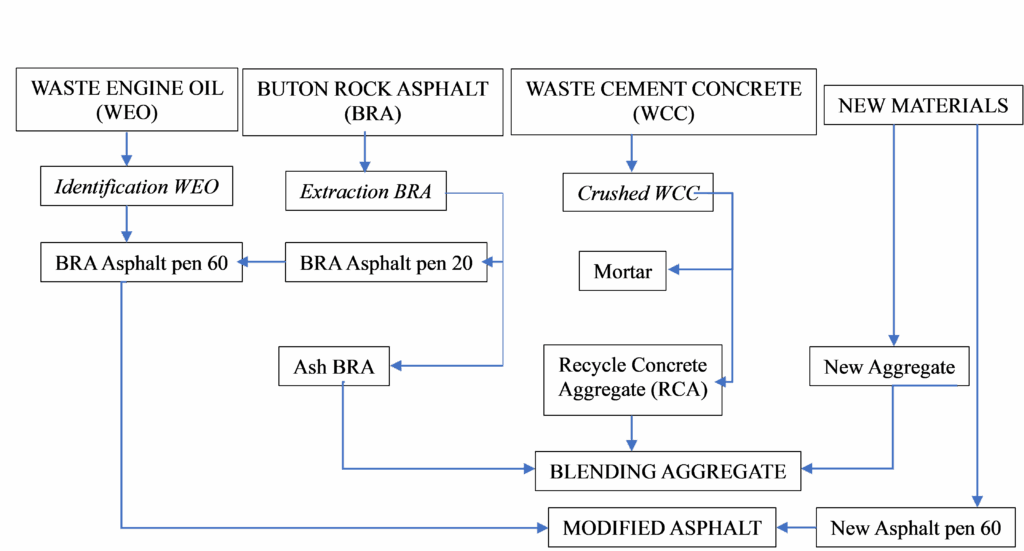
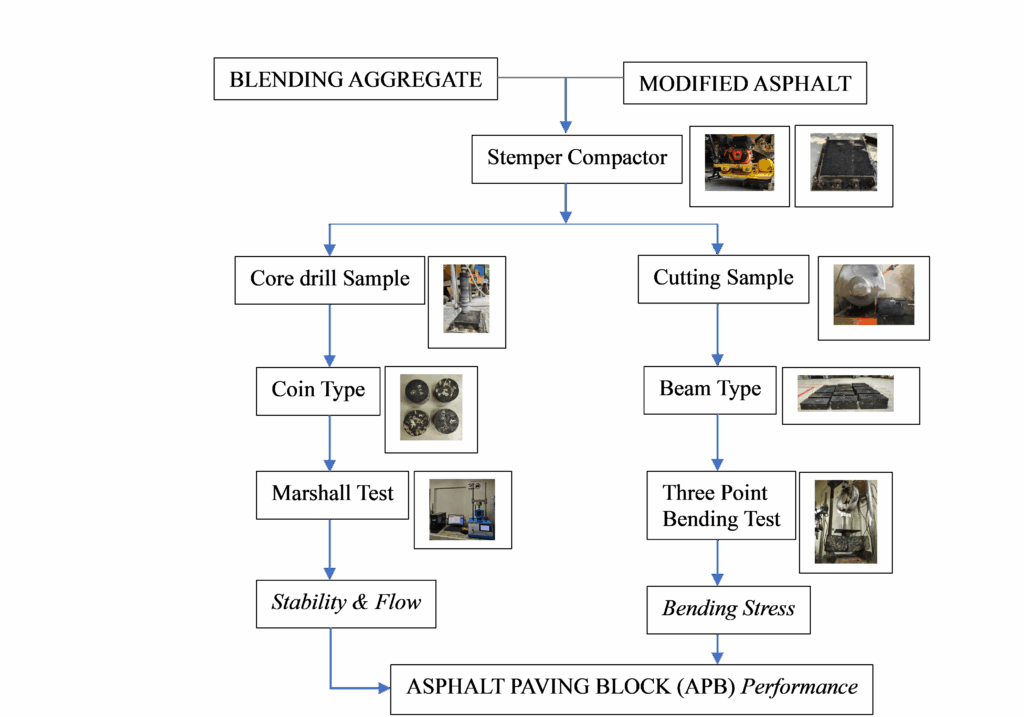
3.1. Viscosity
The results of the asphalt viscosity test are used to determine the ease of mixing and compacting the asphalt aggregate mixture. The viscosity of the mixture of BRA asphalt binder and WEO softener was tested using a Brookfield viscometer according to ASTM D4402 specifications, the amount of torque required to maintain the spindle (62) at a constant speed of 50 revolutions per minute. The viscosity of the entire mixture was also measured at temperatures of 100°C to 160°C. Viscosity testing was carried out on the three types of asphalt, and the results are shown in Figure 7.
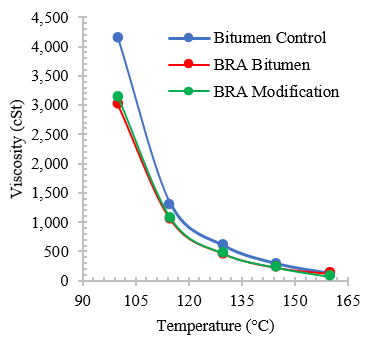
This picture shows that the viscosity value of BRA asphalt modified with WEO has increased compared to that of BRA asphalt without WEO. In forming the ACWC mixture, a viscosity value of 280 Cts is required in the compaction process and 170 Cts in the mixing heating process. In this research, the control ACWC required heating the mixture at a temperature of 151 °C and a compaction temperature of 141 °C, while the Modified ACWC BRA required a lower temperature, namely 145 °C for heating and 136 °C for the compaction process. Thus, the use of Modified BRA reduces temperature requirements by 5 °C. This reduction impacts energy savings, although the reduction is still tiny.
3.2. Asphalt-aggregate mixing.
Material preparation starts with washing the RCA aggregate and softening the BRA with used engine oil by placing both in a closed bag for 24 hours. Hot asphalt mixture consists of 3 types: coarse aggregate, medium aggregate, and fine aggregate. The percentage of each type of aggregate is determined based on the results of the aggregate mixing analysis, as shown in Figure 2. Meanwhile, the composition of new asphalt and BRA asphalt is determined based on an analysis of achieving optimum asphalt content. This research was conducted to assess the effect of using BRA and RCA to optimize the use of natural and waste materials, so the percentage of RCA used is quite large.
Next, the mixing process begins by heating the RCA and BRA materials, which have been soaked in used oil for 24 hours. Second, this aggregate is heated to 145 °C, and new pen grade 60/70 asphalt is heated to up to 140 °C and then poured into the BRA+RCA aggregate asphalt mixture. Using RCA requires precise calculations as HMA material for ACWC NA and BRA+WEO materials.
3.3. Asphalt paving block process.
The BRA-Modified APB is compacted using a Hand-Stemper motor with the resulting density level equivalent to compaction in the Marshall test sample compaction process (Figure 8). The volume of the hot mix asphalt aggregate mixture is calculated from the Marshall density value. This asphalt concrete mixture is divided into three compaction layers to achieve a uniform density level. The compaction temperature is determined as in the Marshall test sample compaction process based on the viscosity value of BRA-Modified asphalt.
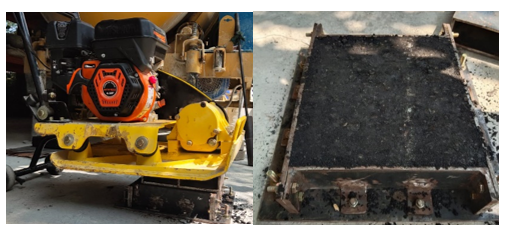
Cutting the HMA-ACWC mixture into APB form is carried out after the sample temperature drops to 26 °C by opening the mold lock. The APB sample is formed with a width of 100 mm and a length of 200 mm, while there are three types of APB height, namely 60 mm, 80 mm, and 100 mm (Figure 9). The APB height is designed to match the height of the mold with different volumes, but the target is to achieve the same density so that the time and amount of compaction are additional for each thickness size.
Cutting the HMA-ACWC mixture into APB form is carried out after the sample temperature drops to 26 °C by opening the mold lock. The APB sample is formed with a width of 100 mm and a length of 200 mm, while there are three types of APB height, namely 60 mm, 80 mm, and 100 mm (figure 9). The APB height is designed to match the height of the mold with different volumes, but the target is to achieve the same density so that the time and amount of compaction are additional for each thickness size.
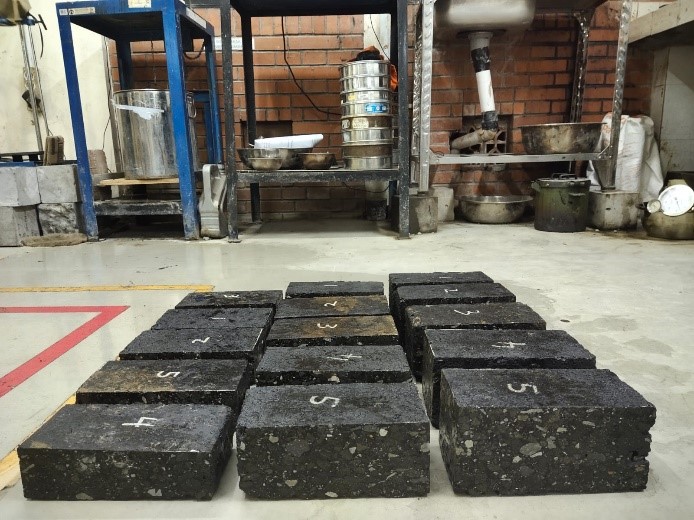
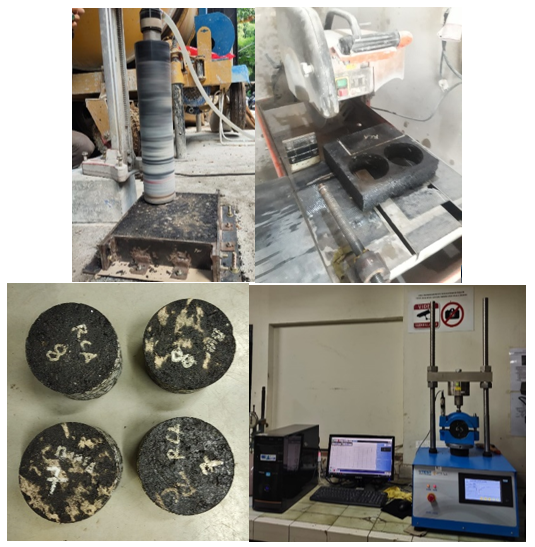
Table 3: Marshall Test Results by Compaction Standard
| No. Sample | VIM (%) | VMA (%) | VFA (%) | Marshall Stability (kg/cm2) | Flow (mm) | Density (kg/cm3) |
| 1 | 5.93 | 22.52 | 73.69 | 830.52 | 3.75 | 2.14 |
| 2 | 6.46 | 22.97 | 71.85 | 773.18 | 3.85 | 2.14 |
| 3 | 5.90 | 22.50 | 73.78 | 846.86 | 3.80 | 2.18 |
| 4 | 4.22 | 21.12 | 80.02 | 859.33 | 3.85 | 2.24 |
| 5 | 4.76 | 21.57 | 77.91 | 858.01 | 3.90 | 2.25 |
| Average | 5.45 | 22.13 | 75.45 | 833.58 | 3.83 |
2.19 |
Marshal Standard and Immersion tests were carried out in this paving block research, where the specimens were obtained using core drilling in a compactor mold, as in Figure 10. The Marshall test was carried out to control the strength of the asphalt aggregate mixture in the form of paving blocks.
3.5. Marshall Standard and Immersion test
Marshall testing has two test methods in this research, namely standard Marshall testing and immersion Marshall testing. The two tests are differentiated by the time the test object is immersed in a water bath. The standard Marshall test takes ±30 minutes to soak the test object at a temperature of 60°C, while the Marshall immersion test is carried out for ±24 hours.
The Marshall test results can be obtained from samples from the Marshall test mold (Table 3) and core drill samples from Hand-Stamper compaction (Table 4). Both tests show suitability for determining the Marshall stability value in the APB aggregate asphalt mixture; the stamper compaction method, core drill sample, and Marshall Standard and Immersion tests were carried out.
3.6. Bending Test
The bending test, also known as the bending test, is one of the essential methods in the field of materials mechanics. This test is carried out to evaluate the ability of a material to withstand bending loads until deformation or cracking occurs. APB performance measurements were performed using compression tests on two supports to determine the flexibility value. The bending test (Figure 11) is essential for APB because the aggregate binder for this material is asphalt, which has a flexibility value, so to achieve specific performance, it is necessary to measure the level of flexibility. Table 5 shows the bending test results of samples with different thicknesses, namely 6 cm, 8 cm, and 10 cm.
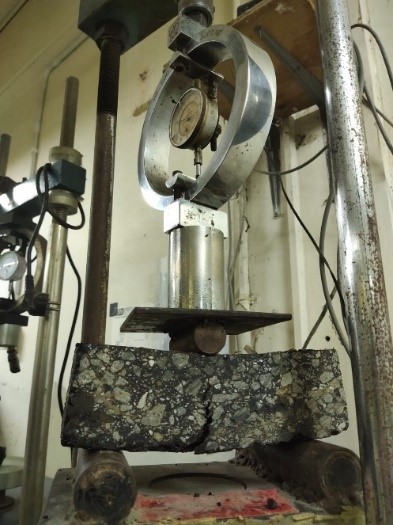
Table 4: Marshall Test Results by Hand-Stemper Compactor
| No. Sample | VIM (%) | VMA (%) | VFA (%) | Marshall Stability (kg/cm2) | Flow (mm) | Density (kg/cm3) |
| 1 | 3.00 | 19.16 | 84.32 | 693.40 | 3.64 | 2.04 |
| 2 | 2.65 | 18.87 | 85.95 | 874.91 | 3.31 | 2.08 |
| 3 | 3.95 | 20.85 | 81.07 | 827.15 | 3.41 | 2.06 |
| 4 | 2.74 | 19.85 | 86.18 | 831.07 | 3.39 | 2.07 |
| 5 | 2.62 | 19.75 | 86.74 | 798.37 | 3.51 | 2.05 |
| Average | 2.99 | 19.70 | 84.85 | 804.98 | 3.45 | 2.06 |
Table 5: APB Bending Test results.
| Thickness (cm) | 6 | ||||
| No. Sample | 1 | 2 | 3 | 4 | 5 |
| Density (kg/cm3) | 2.11 | 2.07 | 2.06 | 2.01 | 2.06 |
| Flexural Strength (MPa) | 8.04 | 6.89 | 6.89 | 5.74 | 6.89 |
| Thickness (cm) | 8 | ||||
| No. Sample | 1 | 2 | 3 | 4 | 5 |
| Density (kg/cm3) | 2.00 | 1.94 | 2.01 | 1.96 | 1.96 |
| Flexural Strength (MPa) | 11.49 | 9.19 | 12.64 | 9.19 | 10.34 |
| Thickness (cm) | 10 | ||||
| No. Sample | 1 | 2 | 3 | 4 | 5 |
| Density (kg/cm3) | 1.96 | 2.02 | 1.97 | 2.02 | 1.99 |
| Flexural Strength (MPa) | 16.08 | 20.68 | 16.08 | 20.68 |
18.38 |
4. Result and Discussion
Using RCA and BRA as BRA-Modified Asphalt Paving Blocks has shown reduced oil asphalt and aggregates as a program for utilizing rock asphalt and recycling cement concrete aggregates. Another study uses simple equipment in the APB-BRA-Modification formation process, so it is necessary to analyze it as described in this section.
4.1. Density evaluation of the Hand-Stemper machine
The BRA-Modified APB performance measurement in this study used the Marshall test. As shown in Figure 12, Sample A is compared with Marshal Standard compaction, and Sample B is compared with Hand-Stemper compaction in the APB printing process. From the five samples, the test results using the Marshall Standard compaction method and the Hand-Stemper compaction method showed differences. However, they were still small, so the five samples showed that the Marshall Stability values were close for the two compaction methods. This research can use this compaction method on this research using the Hand-Stemper can be used in the APB sample compaction process.
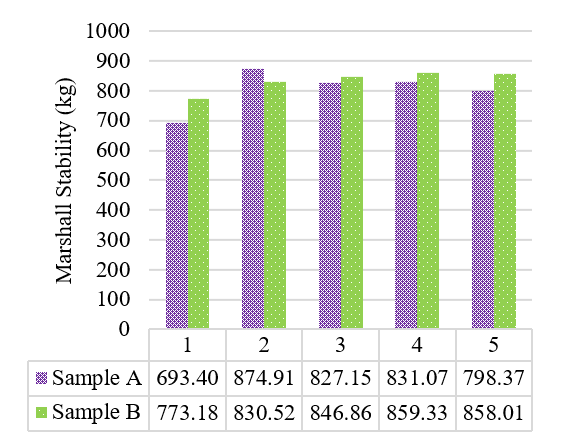
4.2. Effect of RCA on volumetric characteristics of APB-BRA
Using RCA in APB mixtures can reduce the need for new aggregate. In this study, the amount of RCA reached 24% of the total aggregate demand. As shown in Figure 13, using RCA changes the VIM value to smaller when compared to APB without RCA. This condition also occurs for the VMA value, but the results are the opposite for the VFA value. Figure 14 shows that using RCA in APB increases the need for asphalt binder material. This increase can also be seen from the optimum asphalt content (OPC) value, where OPC without RCA is 7.5% while OPC with RCA is 8% of the total mixture.
4.3. Influence of RCA on Flexural Stress Values
Test measurements on road pavement from asphalt aggregate mixtures use the Marshall Standard and Immersion Test, but Concrete Paving block materials generally use the Compression Test. In this research, the properties of asphalt were used to determine the asphalt paving block material using the Bending Test.
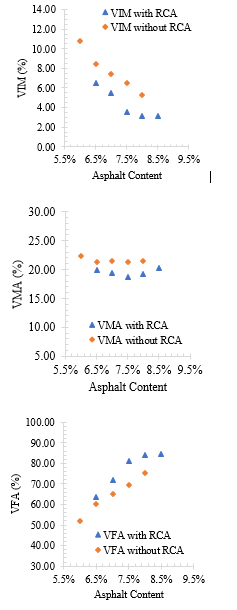
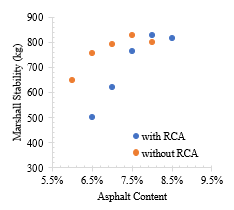
The effect of using RCA as a substitute for new aggregate material has shown an increase in flexural test values of 23.13% (figure 15). This increase is likely due to mortar in the RCA aggregate, which fills the voids in the aggregate.
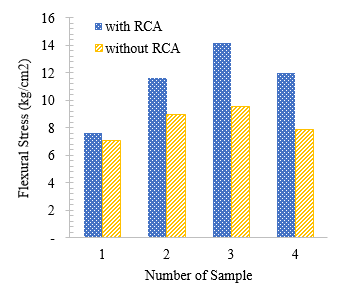
4.4. Volumetric Characteristics of APB-BRA Optimum Asphalt Content
Changes in volumetric characteristics of the APB-BRA material from the influence of temperature and water are shown in Figure 16. The VIM value decreased from 6.06% to 5.28%; there was a decrease of 13%. Likewise, the VMA value decreased by 3%. On the other hand, there was an increase in the VFA value of 4%.
This change shows that the influence of water and soaking at a temperature of 60 °C for 24 hours has changed the volumetric value, decreasing the performance of the APB-BRA mixture.
The effect of water and immersion at a temperature of 60 °C reduces the bond between aggregates by the asphalt binder. This reduced ability of the asphalt binder causes the aggregate to be released from the asphalt, which is called stripping. This kind of process shows the vulnerability of the asphalt aggregate mixture to environmental conditions. This level of vulnerability is measured by comparing samples in submerged and dry conditions.
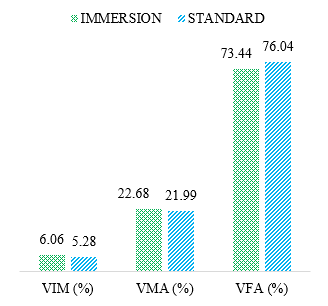
The Residue Stability Index (RSI) compares the Marshall stability (MS) value from the immersion test with the dry test. The vulnerability level of APB-BRA in conditions of Optimal Asphalt Content was measured using Standard Marshall and Marshall Immersion tests (Figure 17). The RSI value of 15 samples for this test shows a value of 71.32%. This value is relatively low, so it is still susceptible to the effects of temperature and water.
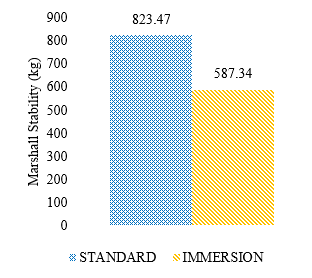
4.5. Marshall Stability and Flexural Stress of APB-BRA
Paving Blocks generally use cement concrete, while APB uses asphalt concrete material. The flexible nature of asphalt makes it possible to determine the performance of APB using the Bending Stress test. The test assessed the performance of the asphalt concrete mixture using the Marshall Standard test with test objects with a circular surface and a thickness of 63.5 mm, with Marshall Stability test results. Meanwhile, testing for APB uses a beam with a surface size of 100 mm wide and 63 mm high, with Flexural Stress test results. Both types of testing use a sample density level of between 2.07 – 2.25 kg/cm3, and the average Marshall test result is 774.56 kg, while for the Bending test, the average is 5.22 kg/cm2.
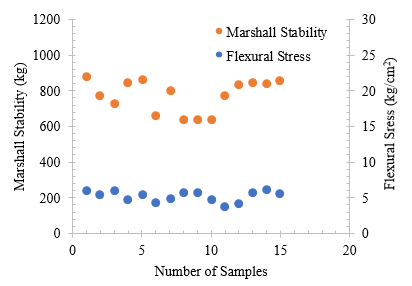
Figure 18 shows the results of the Marshall test and Bending test. Comparing these two test results can help determine targets for achieving APB performance and the performance of asphalt concrete mixtures as a surface layer on pavement structures, which is generally based on the Marshall Stability value.
4.6. Effect of Thickness of APB-BRA on Flexural Stress
In general, testing concrete paving blocks (CPB) using compression tests on paving blocks shows that the thicker the block sample, the decreases the compressive strength value [33]. A similar thing also happened with the flexural stress on APB, an increase in sample thickness showed a slightly reduced flexural stress value, as in Figure 19.
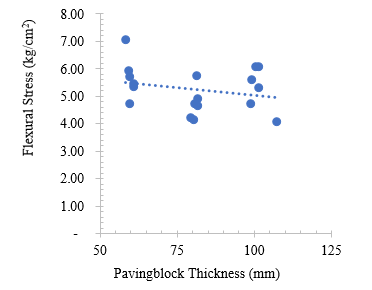
Conclusions
This research aims to use RCA to reduce new aggregates and BRA to minimize the use of petroleum asphalt with WEO softener material. This environmental preservation concept is applied to paving blocks as a material for forming road surfaces. In contrast, the Modified APB-BRA process uses simple equipment so small industries can carry it out. Some concluding notes from this research are as follows:
- The incorporation of Recycled Concrete Aggregate (RCA) and Bitumen-Rubber Aggregate (BRA) in the Modified Hot Mix Asphalt (HMA) presents opportunities for cost reduction and environmental conservation initiatives. The table illustrates the proportions of various materials in both Conventional HMA and Modified HMA, showing that RCA contributes 24% and BRA modified contributes 32.67% to the APB-BRA Modified mixture. However, the inclusion of RCA in this study has led to a slight increase of 0.5% in the total weight of the asphalt aggregate mixture (Table 6).
Table 6: Composition Comparison between Conventional Hot Mix Asphalt (HMA) and Modified HMA Incorporating Bitumen-Rubber Aggregate (BRA)
| Materials | Content | HMA Conventional | HMA-BRA Modified |
| New Asphalt | % | 100.00 | 67.33 |
| BRA bitumen | % | – | 27.77 |
| WEO | % | – | 4.90 |
| New Aggregate | % | 100.00 | 63.00 |
| RCA | % | – | 24.00 |
| BRA granules | % | – | 13.00 |
-
- The test method for APB uses the Bending Test based on the properties of the aggregate asphalt mixture but with Marshall Test control, which is generally the performance measurement for asphalt mixtures on road pavement.
- Innovation in making asphalt paving blocks by utilizing waste material through a recycling process using simple equipment has shown that this solution is better for light-traffic roads, pedestrians, or other facilities.
Declaration of competing interest
The authors declare that they have no known competing financial interests or personal relationships that could have appeared to influence the work reported in this paper.
Acknowledgments
The Faculty of Engineering Universitas Indonesia funded this research through the Seed Funding 2022-2023, financed by contract no. NKB-1960/UN2.F4.D/PPM.00.00/2022. This research was conducted at the Structure and Material Laboratory of the Universitas Indonesia Civil Engineering Department. Thank you for the opportunity to use laboratory facilities for this research.
1. Introduction
The choice of surface layer type on the road pavement structure is adjusted to the road’s intended function of serving traffic volumes during its service life. Other problems are excessive axle load, large-scale vehicles, and side channel damage. These problems cause severe damage to most of the road pavement, and the pavement will likely be repaired.
Paving block material can be used as a road surface for low-traffic or medium-traffic, depending on the height of the paving blocks used. The problem in maintaining road surfaces is resurfacing due to increased load on road surfaces, especially on urban roads. Using concrete paving blocks can improve durability, reduce maintenance requirements, and provide pleasing aesthetics for consumers [1]. Road surface maintenance and dismantling work using paving blocks does not require heavy equipment, which can save costs. This material is widely used on residential roads, driveway access roads, sidewalks, garages, and parking lots. In general, the material size is in the form of blocks measuring 200-100-60 mm consisting of crushed stone, stone ash, sand, cement, and water. This material is a precast product produced in a factory, so it provides good dimensional consistency and accuracy in concrete paving blocks [2]. This pavement has become an attractive engineering and economical alternative to flexible asphalt and cement concrete rigid pavement due to its easy and fast placement, ease of maintenance and removal, resistance to movement and damage, durability, and aesthetic surface [3]. Block paving is used worldwide primarily for its resistance to movement, damage, and aesthetic surface. These features result in longer pavement life, reduced maintenance costs, extended replacement cycles, and reduced raw material usage. In addition, block paving eliminates rainwater runoff and saves land, can be produced using local materials and labor, and is recycled [4].
The increasing demand for paving blocks as a construction material has increased the need for cement [5]. The demand for cement as a building material is also in other buildings, so efforts are needed to find alternative solutions without harming durability and other physical characteristics. The cement production process significantly negatively impacts the environment due to producing carbon dioxide emissions [6].
Another building construction material requirement that requires savings is aggregate. Restrictions on stone mining from a quarry are intended to preserve the environment. Therefore, the agency can use recycling methods to meet the needs of building materials, such as aggregate materials. The need for aggregate to form cement concrete and asphalt concrete requires around 60-75% of the concrete volume, and natural resources cannot be produced shortly.
Research on recycled concrete aggregate (RCA) as a substitute for natural aggregate is continuing, even though RCA has different properties from natural aggregate (NA). In RCA, there is mortar that sticks to the aggregate. As a result, water absorption in RCA was higher than in NA and had a lower work capacity [6] [7]. This absorption is a consequence of the cement mortar adhering to the surface. Higher absorption reduces the amount of water available to combine with the cement; this hurts the mechanical properties of RCA, among other disadvantages [8]. However, the use of RCA with certain technologies is something that promises to reduce the environmental impact of the construction sector and preserve natural resources.
RCA can be processed from several types of concrete waste, such as substantial waste from batching plants, building construction demolition waste, etc. Somebody can apply this waste to engineering or building infrastructure as some components have a high resource value and have previously proven technical sustainability of recycled concrete. Recycling technologies have been developed in road pavements to limit the use of new natural aggregates. Reducing concrete waste can reduce the need for landfills for construction waste, where aggregate is the main component of concrete waste, the most significant construction waste [9]. Waste concrete is original concrete from construction, made by separating mortar from stone, which can be reused. One of the main reasons for using RCA in road pavement is to complete construction work in a more environmentally friendly manner. On a global scale, the construction sector contributes to waste, which increases yearly. Therefore, the construction sector can significantly reduce the amount of concrete waste by using aggregate waste as a road pavement mixture [10]. RCA shape variation will occur during mix preparation due to the bonding mortar.
The paving block forming material can be used as an asphalt binder to substitute Portland cement. This method is an alternative for reducing cement demand, even though using asphalt still hurts carbon emissions from the asphalt heating process at a specific temperature. Depending on availability, asphalt can be used as an aggregate binding material to form paving blocks. A choice of asphalt types is available, including oil asphalt and rock asphalt. There are many types of natural asphalt (mainly rock and lake asphalt). One kind of rock asphalt in the form of natural rock asphalt deposits on Buton Island, Indonesia, has been widely used in recent years [11–13]. Buton Rock Asphalt (BRA) contains large reserves of natural rock asphalt with an average asphalt content of 20% [14].
Natural rock asphalt is formed from a process that combines heat, pressure, oxidation, catalysts, and bacteria after hundreds of millions of years of geological changes in rock fractures [15]. As an additional material, BRA effectively increases the temperature sensitivity of the asphalt. Increasing the BRA content decreases the penetration value gradually while the soft point of asphalt gradually increases. By adding BRA to new asphalt, the ductility value decreases rapidly. Meanwhile, the rheological properties of BRA at high temperatures have a positive modifying effect; on the contrary, it hurts crack resistance at low temperatures [16]. In BRA, there is ash content, which can improve the behavior of oil asphalt at high temperatures and has the best modification effect with a significant specific surface area. The optimal modification effect on the recommended particle size is 200 mesh [17]. Adding Rock Asphalt (RA) can significantly improve the performance of petroleum asphalt binder at high temperatures. More details show that higher RA dosage results in better high-temperature performance and shows little adverse effect on the performance of binder and asphalt mixture at low temperatures [18]. Resistance to wheel groove deformation of asphalt mixed with rock asphalt (RA) increases with increasing dosage. However, the effect of BRA dose on variations in groove resistance is smaller than the resistance to water impact and high temperatures [19]. BRA is an excellent modifier due to its low cost and excellent compatibility with petroleum asphalt because BRA and petroleum asphalt are both petroleum derivatives. Many studies have verified the remarkable effects of RA as a modifier in improving the strength, high-temperature stability, aging resistance, and weather resistance of asphalt pavements [20,21]. The BRA-modified asphalt mixture has a much higher durability modulus. The influence of temperature, service time, traffic volume, and loading time on the resistance modulus shows that BRA-modified asphalt mixtures have better performance on these factors than unmodified asphalt mixtures [22]. One of the waste oils that is reused as a rejuvenation material in the road asphalt industry is WEO. This used oil can reduce the viscosity of old asphalt and increase the potency of the asphalt mixture. Using 15% waste engine oil (WEO) as a BRA softener increases BRA utilization. It reduces the use of pure asphalt (oil asphalt) up to 32% of the total weight of BRA-modified asphalt at penetration 60. The study results show that this method can increase BRA utilization and reduce the need for petroleum asphalt [23].
The composition of WEO is very complex, but most of its chemical compounds are low-weight components, such as aromatic solvents, paraffin oils, and polyolefin oils, similar to aromatics in asphalt [24]. Reusing used oil as a rejuvenation material in the road pavement industry can help reduce the amount of used oil waste that becomes B3 waste. This waste is used as a softener or rejuvenator for old asphalt by curing for 24 hours with a certain percentage until the properties of the old asphalt approach those of the new asphalt, especially at the planned penetration value [25]. Previous research found that adding waste oil can increase penetration value, decrease softening point, and decrease ductility and asphalt viscosity, thereby reducing the production temperature and compaction of the asphalt mixture [26–29]. Similar observations have been made on the softening and elasticity properties, so using 50% aged asphalt is relatively helpful in restoring the physical properties [30]. The results show that all types of waste oil can increase anti-aging properties. Because motor oil and asphalt binder are products of petroleum refining, some contractors have investigated blending used motor oil as a potential binder replacement or rejuvenator when joining reclaimed asphalt pavements [31]. Used oil can improve the performance of old asphalt by adding lightweight components. And as a modifier, the influence of WEO on the performance of various types of asphalt is receiving increasing attention. However, there are drawbacks to using WEO in asphalt mixtures. Some disadvantages are that the viscosity of the used oil is relatively high, causing uneven distribution of the asphalt mixture. In addition, using this softening agent causes a decrease in the elastic properties of asphalt and groove resistance [32].
The main objective of this research is to conduct a study on the design of asphalt paving blocks using BRA, waste concrete aggregate, and waste engine oil. This waste material utilization research aims to determine the combination of aggregate waste utilization in BRA and RCA by including WEO as a softening agent for BRA asphalt. In this way, savings are obtained from the use of new materials. This recycled material is processed to achieve aggregate asphalt mixture performance at certain specifications. The development of waste utilization in this research still refers to previous research by optimizing the performance of the remaining material. Thus, using materials in this way can contribute more to environmental sustainability.
2. Materials
2.1. Asphalt Binder
The asphalt binder in this study consisted of Pen 60/70 quality oil asphalt in the form of new asphalt called fresh asphalt, added with asphalt extracted from Buton Rock Asphalt (BRA). Conventional property tests have been carried out on both types of asphalt; namely, the 25 °C penetration test (ASTM D5) shows the asphalt’s consistency in deformation resistance at a temperature of 25 °C. The ductility test (ASTM D113) states the ability of asphalt to deform plastic before it reaches failure. The softening point test (ASTM D36) indicates resistance to high temperatures. The viscosity test (ASTM D4402) shows that material viscosity is related to the ease of mixing the asphalt aggregate at a specific temperature. Asphalt changes its properties when used as a binder. Penetration and ductility values will decrease significantly.
Meanwhile, the soft point value will increase as the time of use increases. These changes are a mechanism for asphalt to achieve the aging process. Therefore, old asphalt will lose its aromatic content and increase the asphaltene content. Generally, asphalt with a low asphaltene content is susceptible and flexible to high temperatures. The properties of BRA are like the properties of old asphalt. The test results can be seen in Table 1.
2.2. Waste engine oil.
The WEO used is often found in car maintenance workshops. This research took material from three car service workshop locations, two of which have the same characteristics. From this place, brownish-black WEO was obtained. The viscosity value at 25 °C is 121-126 cP. WEO is a softening agent for BRA asphalt because BRA granules are stone and have low penetration. Figure 1 shows the change in BRA penetration value by adding WEO. By adding 15% WEO, a penetration value of 60 can be achieved. Furthermore, the BRA that WEO has softened is called Modified BRA.
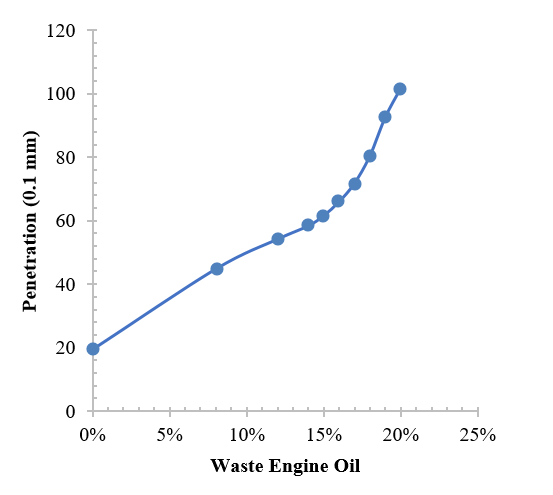
2.3. Aggregate
In this research, three types of aggregate were used; the first was an asphalt concrete mixture using asphalt and a new aggregate. Meanwhile, the second is an asphalt concrete mixture with the addition of BRA. The third type is a mixture of new aggregate, asphalt, BRA, and concrete waste aggregate. It can be a combination of the three types of aggregate with the composition of BRA (13%), RCA (24%), and new aggregate (63%).
The aggregate composition is obtained according to the plan specifications (Figure 2).
Table 1: New Asphalt Pen 60/70 Characteristics.
| No. | Type of Testing | Testing Method | Unit | New Asphalt | BRA |
| 1 | Penetration at 25 °C | ASTM D-5 | 0.1 mm | 68.2 | 11.4 |
| 2 | Softening Point | ASTM-D36 | °C | 48.3 | 75.3 |
| 3 | Flash Point | ASTM D-92 | °C | 281.4 | 273.3 |
| 4 | Ductility at 25 °C | ASTM-D113 | cm | 102.7 | 5.43 |
| 5 | Specific Gravity at 25 °C | ASTM-D70 | gr/cm3 | 1.07 | 1.42 |

2.4. New Aggregate (NA)
As an asphalt material, BRA has an additional influence on preparing new aggregate. This effect is caused by the fine-grained material contained in BRA. Inspection of aggregates, including fine BRA material, is carried out. The new aggregate is obtained from a stone-crushing company. Testing of aggregate physical properties includes gradation tests passing through a sieve, Los Angeles tests, and specific gravity tests. New aggregate is added to the recycling process to replace changes in aggregate of a particular size due to vehicle loading during service life.
2.5. BRA Extraction
In BRA, there is fine-grained material, and these refined grains can be used as fine aggregate. Before BRA is used as a hot or warm mix material, it is necessary to know the asphalt and fine mineral content. Asphalt and fine minerals are separated through an extraction process using a centrifuge extractor. The results of the extraction test from BRA material are used as a basis for calculations in preparing the asphalt content in the mixture, which is a combination of BRA asphalt and new asphalt, as well as the contribution of BRA mineral ash in the aggregate structure. The results of BRA asphalt extraction consist of BRA granules (a), BRA bitumen (b), and BRA fine granules (c), shown in Figure 3.
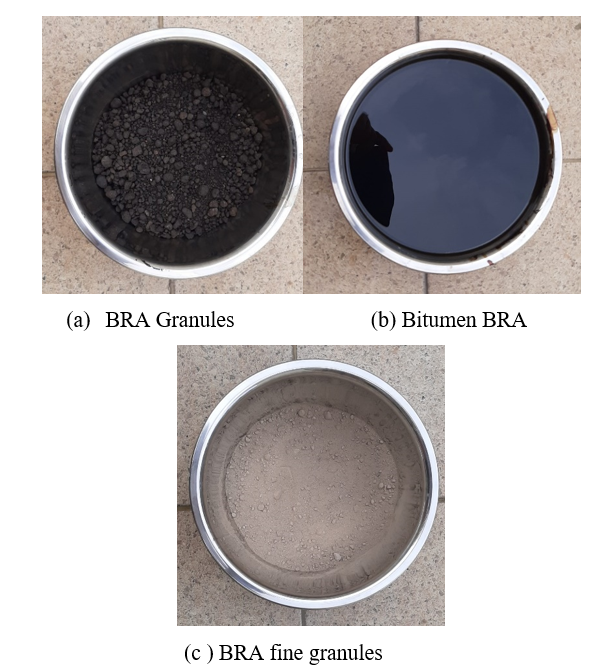
2.6. RCA
This research used RCA in the asphalt mixture to partially replace the new aggregate. The RCA content as a substitute for new aggregates is calculated based on the composition of the RCA aggregates, so there are limitations to specific amounts. Increasing the amount of RCA in the asphalt concrete mixture can increase the optimum asphalt content. RCA aggregate differs from natural aggregate because it consists of two materials: natural aggregate and embedded cement mortar. Cement mortar causes weaknesses in recycled aggregates, such as lower density and higher absorption, Los Angeles abrasion, and sulfate content [23].
Table 2: Aggregate characteristics.
|
No. |
Type of Testing | Testing Method | Unit | New aggregate. | RCA aggregate |
| 1 | Specific Gravity | SNI 1970:2016 | gram/cm3 | 2.75 | 2.60 |
| 2 | Absorption | SNI 1970:2016 | % | 1.58 | 1.84 |
| 3 | Los Angeles abrasion | SNI 2417:2008 | % | 17.6 |
23.6 |
Using RCA particles requires preliminary examination to overcome the problem of the mortar’s impact and increase the mixture’s performance (especially resistance to moisture damage).
The RCA used in this research was obtained from the batching plant location. Before use, the RCA chunks are crushed with a stone crusher to separate the rock grains from their respective bonds. Next, the rock grains are washed to remove mortar from the surface. The washing process is carried out so that the aggregate does not contain dust or other fine materials. The characteristics of RCA aggregates are shown in Table 2 and Figure 4.
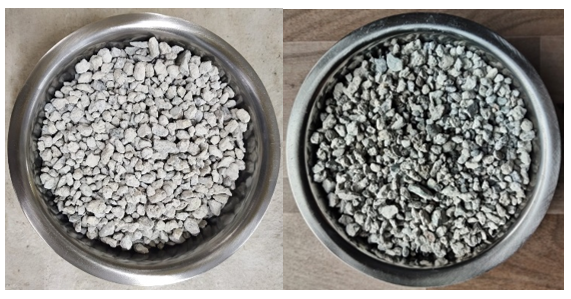
3. Design Methodology
Asphalt Paving Block (APB) research uses Hot-Mix Asphalt (HMA) specifications for the Asphalt Concrete Wearing Coarse (ACWC) type as the asphalt concrete mixture in the APB. Three kinds of HMA materials are used in this research: a new aggregate asphalt mixture as a control for test results, two asphalt mixtures using BRA, and a third BRA asphalt mixture using recycled RCA aggregate. Preparing this research activity consists of several stages, as described in the flowchart in Figure 5.
From the identification of BRA characteristics, which consists of identifying BRA bitumen, it is separated from the refined grains using an extraction test. The bitumen content of each BRA quarry can vary; in this research, BRA was obtained from the Lawelle location. Another identification of WEO is its viscosity value. Next, the low penetration BRA is softened using WEO. Aggregate identification begins by breaking up Cement Concrete Waste (CCW) to separate the mortar from the aggregate. The user washed the RCA aggregate and the sieve analysis test to determine the composition of the aggregate. Next, the RCA aggregate, new aggregate, and Ash-BRA are mixed with a specific composition based on sieve analysis to meet the technical specifications of Asphalt Concrete Wearing Coarse (ACWC). RCA reduces the use of new aggregate in this asphalt concrete mixture.
The final stage is the formation of this modified BRA asphalt concrete mixture into an APB in specific dimensions, and then tests are carried out to determine its performance.
ACWC-BRA modified hot mixture is carried out by compaction process using a Stemper Compactor in a rectangular mold with a density level equal to the density in the Marshall test. The results of this compaction are tested using two types of tests: the Marshall Standard and the Three-Point Bending tests. Figure 6 shows the test method in this research, where the Marshall sample is obtained from a core drill sample while the three-point bending sample is obtained by cutting the sample. Marshall Stability, flow, and Flexural Stress values measure APB performance.
- V. Limbachiya, E. Ganjian, P. Claisse, “Strength, durability and leaching properties of concrete paving blocks incorporating GGBS and SF,” Construction and Building Materials, 113, 273–279, 2016, doi:10.1016/j.conbuildmat.2016.02.152.
- E. Ganjian, G. Jalull, H. Sadeghi-Pouya, “Using waste materials and by-products to produce concrete paving blocks,” Construction and Building Materials, 77, 270–275, 2015, doi:10.1016/j.conbuildmat.2014.12.048.
- C.S.G. Penteado, E. Viviani De Carvalho, R.C.C. Lintz, “Reusing ceramic tile polishing waste in paving block manufacturing,” Journal of Cleaner Production, 112, 514–520, 2016, doi:10.1016/j.jclepro.2015.06.142.
- A.R. Djamaluddin, M.A. Caronge, M.W. Tjaronge, A.T. Lando, R. Irmawaty, “Evaluation of sustainable concrete paving blocks incorporating processed waste tea ash,” Case Studies in Construction Materials, 12, 2020, doi:10.1016/j.cscm.2019.e00325.
- M.N. Soutsos, K. Tang, S.G. Millard, “Use of recycled demolition aggregate in precast products, phase II: Concrete paving blocks,” Construction and Building Materials, 25(7), 3131–3143, 2011, doi:10.1016/j.conbuildmat.2010.12.024.
- H. Qasrawi, I. Asi, “Effect of bitumen grade on hot asphalt mixes properties prepared using recycled coarse concrete aggregate,” Construction and Building Materials, 121, 18–24, 2016, doi:10.1016/j.conbuildmat.2016.05.101.
- X. Xu, Y. Luo, A. Sreeram, Q. Wu, G. Chen, S. Cheng, Z. Chen, X. Chen, “Potential use of recycled concrete aggregate (RCA) for sustainable asphalt pavements of the future: A state-of-the-art review,” Journal of Cleaner Production, 344, 2022, doi:10.1016/j.jclepro.2022.130893.
- M.S. de Juan, P.A. Gutiérrez, “Study on the influence of attached mortar content on the properties of recycled concrete aggregate,” Construction and Building Materials, 23(2), 872–877, 2009, doi:10.1016/j.conbuildmat.2008.04.012.
- C.M. Nwakaire, S.P. Yap, C.W. Yuen, C.C. Onn, S. Koting, A.M. Babalghaith, “Laboratory study on recycled concrete aggregate based asphalt mixtures for sustainable flexible pavement surfacing,” Journal of Cleaner Production, 262, 2020, doi:10.1016/j.jclepro.2020.121462.
- N. Makul, R. Fediuk, M. Amran, A.M. Zeyad, S. Klyuev, I. Chulkova, T. Ozbakkaloglu, N. Vatin, M. Karelina, A. Azevedo, Design strategy for recycled aggregate concrete: A review of status and future perspectives, Crystals, 11(6), 2021, doi:10.3390/cryst11060695.
- M.C. Liao, J.S. Chen, G.D. Airey, S.J. Wang, “Rheological behavior of bitumen mixed with Trinidad lake asphalt,” Construction and Building Materials, 66, 361–367, 2014, doi:10.1016/j.conbuildmat.2014.05.068.
- M. Wang, C. Xing, “Evaluation of microstructural features of Buton rock asphalt components and rheological properties of pure natural asphalt modified asphalt,” Construction and Building Materials, 267, 2021, doi:10.1016/j.conbuildmat.2020.121132.
- S. Liu, W. Cao, X. Li, Z. Li, C. Sun, “Principle analysis of mix design and performance evaluation on Superpave mixture modified with Buton rock asphalt,” Construction and Building Materials, 176, 549–555, 2018, doi:10.1016/j.conbuildmat.2018.05.045.
- N. Suaryana, “Performance evaluation of stone matrix asphalt using indonesian natural rock asphalt as stabilizer,” International Journal of Pavement Research and Technology, 9(5), 387–392, 2016, doi:10.1016/j.ijprt.2016.09.007.
- F. Ma, Y. Wang, Z. Fu, Y. Tang, J. Dai, C. Li, W. Dong, “Thermal ageing mechanism of a natural rock-modified asphalt binder using Fourier Transform Infrared Spectroscopy analysis,” Construction and Building Materials, 335, 2022, doi:10.1016/j.conbuildmat.2022.127494.
- Y. Zhang, W. Lu, D. Han, H. Guo, X. Peng, W. Zhu, N. Xie, X. Zuo, H. Zhang, Q. Pan, M. Xie, “Laboratory investigation of modified asphalt containing buton rock asphalt or ash from buton rock asphalt,” Case Studies in Construction Materials, 18, 2023, doi:10.1016/j.cscm.2023.e02124.
- W. Lu, X. Peng, S. Lv, Y. Yang, J. Wang, Z. Wang, N. Xie, “High-temperature properties and aging resistance of rock asphalt ash modified asphalt based on rutting index,” Construction and Building Materials, 363, 2023, doi:10.1016/j.conbuildmat.2022.129774.
- K. Zhong, X. Yang, S. Luo, “Performance evaluation of petroleum bitumen binders and mixtures modified by natural rock asphalt from Xinjiang China,” Construction and Building Materials, 154, 623–631, 2017, doi:10.1016/j.conbuildmat.2017.07.182.
- J. Ren, B. Xue, L. Zhang, W. Liu, D. Li, Y. Xu, “Characterization and prediction of rutting resistance of rock asphalt mixture under the coupling effect of water and high-temperature,” Construction and Building Materials, 254, 2020, doi:10.1016/j.conbuildmat.2020.119316.
- S. Lv, X. Peng, C. Liu, F. Qu, X. Zhu, W. Tian, J. Zheng, “Aging resistance evaluation of asphalt modified by Buton-rock asphalt and bio-oil based on the rheological and microscopic characteristics,” Journal of Cleaner Production, 257, 2020, doi:10.1016/j.jclepro.2020.120589.
- S.P. Hadiwardoyo, E.S. Sinaga, H. Fikri, “The influence of Buton asphalt additive on skid resistance based on penetration index and temperature,” Construction and Building Materials, 42, 5–10, 2013, doi:10.1016/j.conbuildmat.2012.12.018.
- M. Karami, H. Nikraz, S. Sebayang, L. Irianti, “Laboratory experiment on resilient modulus of BRA modified asphalt mixtures,” International Journal of Pavement Research and Technology, 11(1), 38–46, 2018, doi:10.1016/j.ijprt.2017.08.005.
- S.P. Hadiwardoyo, R.J. Sumabrata, A.C. Nissa, F.A. Muhammad, M. Hia, D. Iskandar, R.H. Lumingkewas, “Improvement of Buton Rock Asphalt Performance by Adding Nano-Crumb Rubber and Waste Engine Oil,” International Journal of Pavement Research and Technology, 16(5), 1181–1195, 2023, doi:10.1007/s42947-022-00189-4.
- S. Liu, A. Peng, J. Wu, S.B. Zhou, “Waste engine oil influences on chemical and rheological properties of different asphalt binders,” Construction and Building Materials, 191, 1210–1220, 2018, doi:10.1016/j.conbuildmat.2018.10.126.
- H.H. Joni, R.H.A. Al-Rubaee, M.Kh. Shams, “Assessment of Durability Properties of Reclaimed Asphalt Pavement Using Two Rejuvenators: Waste Engine Oil and Asphalt Cement (60-70) Penetration Grade,” IOP Conference Series: Materials Science and Engineering, 1090(1), 012001, 2021, doi:10.1088/1757-899x/1090/1/012001.
- H. Li, F. Zhang, Z. Feng, W. Li, X. Zou, “Study on waste engine oil and waste cooking oil on performance improvement of aged asphalt and application in reclaimed asphalt mixture,” Construction and Building Materials, 276, 2021, doi:10.1016/j.conbuildmat.2020.122138.
- A.K. Banerji, D. Chakraborty, A. Mudi, P. Chauhan, “Characterization of waste cooking oil and waste engine oil on physical properties of aged bitumen,” Materials Today: Proceedings, 59, 1694–1699, 2022, doi:10.1016/j.matpr.2022.03.401.
- I.A. Qurashi, A.K. Swamy, “Viscoelastic properties of recycled asphalt binder containing waste engine oil,” Journal of Cleaner Production, 182, 992–1000, 2018, doi:10.1016/j.jclepro.2018.01.237.
- S.R.M. Fernandes, H.M.R.D. Silva, J.R.M. Oliveira, “Developing enhanced modified bitumens with waste engine oil products combined with polymers,” Construction and Building Materials, 160, 714–724, 2018, doi:10.1016/j.conbuildmat.2017.11.112.
- A. Eltwati, A. Mohamed, M.R. Hainin, E. Jusli, M. Enieb, “Rejuvenation of aged asphalt binders by waste engine oil and SBS blend: Physical, chemical, and rheological properties of binders and mechanical evaluations of mixtures,” Construction and Building Materials, 346, 2022, doi:10.1016/j.conbuildmat.2022.128441.
- X. Jia, B. Huang, B.F. Bowers, S. Zhao, “Infrared spectra and rheological properties of asphalt cement containing waste engine oil residues,” Construction and Building Materials, 50, 683–691, 2014, doi:10.1016/j.conbuildmat.2013.10.012.
- Z. Liu, S. Li, Y. Wang, “Characteristics of asphalt modified by waste engine oil / polyphosphoric acid: Conventional, high-temperature rheological, and mechanism properties,” Journal of Cleaner Production, 330, 2022, doi:10.1016/j.jclepro.2021.129844.
- R.H. Lumingkewas, S.P. Hadiwardoyo, F.A. Hadiwardoyo, “Laboratory Innovation to Investigate Concrete Paving Blocks Compressive Strength,” Civil Engineering Journal (Iran), 9(11), 2672–2688, 2023, doi:10.28991/CEJ-2023-09-11-03.
